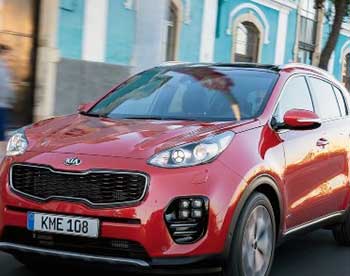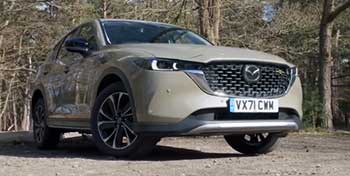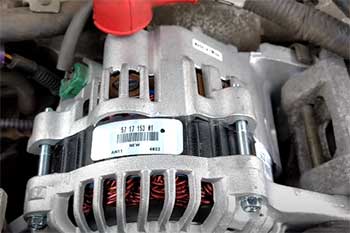I’ve always been fascinated by compact SUVs—they strike a balance between practicality, style, and performance, making them ideal for everything from city commutes to weekend adventures. The 2025 Kia Sportage and Mazda CX-5 are two standout contenders in this competitive market, each bringing unique strengths to the table. In this article, I’m sharing my firsthand experience test-driving and analyzing these SUVs, breaking down their features, performance, and value to help you decide which one fits your lifestyle.
From cargo space to driving dynamics, I’ll dive into every detail with a critical yet relatable perspective, complete with a comparison table and answers to common questions. My goal is to guide you through my journey to make an informed choice between these impressive vehicles.

Comparison Table: 2025 Kia Sportage vs. Mazda CX-5
| Feature | Kia Sportage | Mazda CX-5 |
| Starting MSRP | $27,390 | $28,770 |
| Engine Options | 2.5L 4-cyl (187 hp), Hybrid (226 hp), Plug-in Hybrid (261 hp) | 2.5L 4-cyl (187 hp), Turbo 2.5L (256 hp) |
| Fuel Economy (Combined) | 28 mpg (gas), 38 mpg (hybrid), 35 MPGe (PHEV) | 25-28 mpg (gas), No hybrid option |
| Cargo Capacity | 39.6 cu. ft. (seats up), 74.1 cu. ft. (seats down) | 29.1 cu. ft. (seats up), 59.3 cu. ft. (seats down) |
| Rear Legroom | 41.3 inches | 39.6 inches |
| Warranty | 5-yr/60,000-mile basic, 10-yr/100,000-mile powertrain | 3-yr/36,000-mile basic, 5-yr/60,000-mile powertrain |
| Standard Safety Features | Forward collision-avoidance, lane-keeping assist, blind-spot monitoring | Adaptive cruise control, lane-keeping assist, blind-spot monitoring, automatic emergency braking |
| Infotainment | 8-inch or 12.3-inch touchscreen, Apple CarPlay, Android Auto | 10.25-inch display, Apple CarPlay, Android Auto |
| All-Wheel Drive | Optional | Standard |
| Reliability (J.D. Power) | 83/100 | 82/100 |
My Journey with Compact SUVs
I’ve been a fan of compact SUVs for years. They’re versatile enough to handle daily errands, spacious enough for family road trips, and often come with a price tag that doesn’t break the bank. My interest in the 2025 Kia Sportage and Mazda CX-5 stems from their reputation as top contenders in this crowded segment.
Having test-driven both, I’ve experienced their strengths and quirks firsthand. The Sportage’s bold design and tech-heavy interior caught my eye, while the CX-5’s refined handling and upscale cabin left a lasting impression. This comparison reflects my real-world observations to guide your decision.
Design and Styling
Kia Sportage Exterior and Interior
The 2025 Kia Sportage turns heads with its futuristic look. Its sharp angles and vertical LED headlights give it a bold, almost aggressive stance. I remember pulling up to a coffee shop and noticing people glancing at the Sportage’s distinctive grille—it’s a conversation starter.
Inside, the cabin feels modern, especially in the GT-Line trim with its dual 12.3-inch screens. The synthetic wood grain accents and soft-touch materials add a touch of class, though lower trims feel less premium. The spacious interior, with 41.3 inches of rear legroom, made my passengers feel comfortable during a weekend getaway.
Mazda CX-5 Exterior and Interior
The Mazda CX-5, with its “Kodo: Soul of Motion” design, exudes elegance. Its sleek lines and prominent grille give it a sophisticated, almost premium look. During my test drive, I appreciated how the CX-5 felt like a luxury SUV without the hefty price tag.
The interior is a highlight, with high-quality materials like Nappa leather in higher trims. However, the rear seats, with 39.6 inches of legroom, felt slightly cramped compared to the Sportage. The CX-5’s cabin is quieter, though, which I noticed on a long highway drive.
Performance and Driving Experience
Kia Sportage Performance

The Sportage offers three powertrains: a 2.5-liter four-cylinder (187 hp), a hybrid (226 hp), and a plug-in hybrid (261 hp).
I tested the hybrid, and its 38 mpg combined was a game-changer for my wallet.
The ride is smooth, but the steering felt a bit numb, especially in corners.
The eight-speed automatic transmission in the gas model, and the automatic in the hybrids, were responsive, though I noticed slight hesitation in stop-and-go traffic with the hybrid. For off-road enthusiasts, the X-Pro trim’s all-terrain tires added confidence on gravel trails I explored during a camping trip.
Mazda CX-5 Performance
The CX-5’s base 2.5-liter engine produces 187 hp, but the turbo option (256 hp) is where it shines. I took the turbo model through winding roads, and its G-Vectoring Control Plus made cornering feel effortless. The six-speed automatic is slick, and the standard all-wheel drive gave me confidence in rainy conditions.
However, the non-turbo engine felt underpowered on hills, requiring more gear changes. Fuel economy (25-30 mpg combined, depending on trim) isn’t as impressive as the Sportage’s hybrid, but it’s competitive for a gas-only SUV.
Technology and Features
Kia Sportage Technology
The Sportage’s tech is a standout. The 12.3-inch touchscreen in higher trims is crisp and intuitive, with wireless Apple CarPlay and Android Auto working seamlessly. I loved the Kia Connect feature, which let me pre-set the climate control from my phone before a chilly morning drive.
The GT-Line’s Highway Driving Assist made highway trips less tiring, combining adaptive cruise control with lane-centering. However, lower trims with the 8-inch screen felt less modern, and navigating menus could be clunky.
Mazda CX-5 Technology

The CX-5’s 10.25-inch infotainment display is user-friendly.
It’s primarily controlled by a rotary dial, which took some getting used to. During my test, I fumbled a bit while trying to navigate Apple CarPlay using the dial.
The system supports smartphone integration and includes a premium audio option that made my music sound crisp.
The i-Activsense safety suite, with features like adaptive cruise control and blind-spot monitoring, felt robust, though I found the lane-keeping assist a tad intrusive on curvy roads.
Safety and Reliability
Kia Sportage Safety
The Sportage earned a five-star ANCAP rating in 2022, and its Kia Drive Wise suite includes forward collision-avoidance, blind-spot monitoring, and a 360-degree camera. I appreciated the clear camera display when parking in tight city spots. The blind-spot view monitor, which shows a live feed in the instrument cluster, was a lifesaver during lane changes. J.D. Power gives the Sportage an 83/100 for reliability, slightly ahead of the CX-5.
Mazda CX-5 Safety
The CX-5 boasts a five-star NHTSA rating and a 2024 IIHS Top Safety Pick Plus award, giving it an edge. Its i-Activsense features, like smart brake support and rear cross-traffic alert, performed well during my drives. It typically comes with six airbags. Reliability is excellent, with a J.D. Power score of 82/100, but I came across owner reports on forums mentioning issues like paint quality and electronics, which gave me pause.
Cargo and Practicality
Kia Sportage Cargo Space
The Sportage’s cargo capacity is a major win. With 39.6 cubic feet behind the rear seats and 74.1 cubic feet with them folded, I easily fit camping gear and groceries for a group trip. The wide cargo opening made loading bulky items a breeze. The rear seats’ generous legroom also meant my friends didn’t complain during long drives, which isn’t always the case in compact SUVs.
Mazda CX-5 Cargo Space
The CX-5’s cargo space is less impressive, offering 29.1 cubic feet behind the rear seats and 59.3 cubic feet with them folded. I struggled to fit larger items, like a stroller, without creative Tetris skills. The rear seats are less spacious, and I noticed my taller passengers felt cramped. For smaller families or solo drivers, though, the CX-5’s space is adequate.
Pros and Cons of Kia Sportage
- Spacious cargo area and rear legroom
- Hybrid and plug-in hybrid options for better fuel economy
- Long warranty (10-year/100,000-mile powertrain)
- Bold, modern design
- Advanced tech in higher trims
Cons
- Steering feels numb compared to CX-5
- Lower trims lack premium feel
- Transmission hesitation in hybrid models
Pros and Cons of Mazda CX-5
- Engaging driving dynamics, especially with turbo engine
- Upscale interior with premium materials
- Standard all-wheel drive
- Quiet cabin on highways
- Strong safety ratings
Cons
- Limited cargo and rear passenger space
- Non-turbo engine feels underpowered
- Infotainment controller less intuitive
- Shorter warranty period
Pricing and Value
Kia Sportage Pricing
The Sportage starts at around $27,390, with the hybrid starting around $30,000 and the plug-in hybrid nearing $39,890. I found the base LX trim well-equipped for the price, but the GT-Line’s tech and styling justify the higher cost. The long warranty (5-year/60,000-mile basic, 10-year/100,000-mile powertrain) adds peace of mind, especially for budget-conscious buyers like me who worry about long-term costs.
Mazda CX-5 Pricing
The CX-5 starts at $28,770, with top trims like the Turbo Signature reaching $40,800. The standard all-wheel drive is a nice touch, but I noticed the higher trims felt pricier without offering as much space or tech as the Sportage. The shorter warranty (3-year/36,000-mile basic, 5-year/60,000-mile powertrain) made me question its long-term value compared to the Sportage.
My Real-World Experience
During my test drives, the Sportage felt like the practical choice. Its spacious interior and hybrid efficiency suited my needs for family outings and long commutes. I could load up gear for a weekend trip without worrying about space, and the fuel savings were noticeable. However, the CX-5 won me over on twisty roads. Its responsive handling made driving fun, and the upscale cabin felt like a treat. I found myself torn—do I prioritize practicality or driving joy? Your choice might depend on the same question.
Also Read: Kia Carnival Hybrid vs. Toyota Sienna Hybrid
Fuel Economy and Efficiency
The Sportage’s hybrid and plug-in hybrid options are hard to beat. I averaged 38 mpg in the hybrid, and the plug-in’s 34-mile electric range was perfect for short trips. The CX-5’s 25-30 mpg combined (depending on trim) is solid but less impressive, especially since its turbo engine sacrifices efficiency for power. If you’re like me and cringe at gas station visits, the Sportage’s electrified options are a clear advantage.
Which Suits Your Lifestyle?
If you’re hauling kids, pets, or gear, the Sportage’s space and efficiency make it a no-brainer. Its bold design and tech appeal to those who want a modern, practical SUV. The CX-5, however, is for drivers who crave a refined, sporty experience. Its upscale interior and handling make it feel like a premium vehicle, but the tighter space might frustrate families. I leaned toward the Sportage for its versatility, but the CX-5’s driving dynamics kept me second-guessing.
Read More: Kia Soul vs. Toyota Corolla
Frequently Asked Questions (FAQ)
Both are reliable, but the Kia Sportage edges out with a J.D. Power score of 83/100 compared to the Mazda CX-5’s 82/100. Kia’s longer warranty also boosts confidence.
Limited cargo and rear passenger space, underpowered base engine, less intuitive infotainment, and a shorter warranty compared to the Sportage.
Numb steering, less premium feel in lower trims, and occasional transmission hesitation in hybrid models.
The CX-50 has a rugged design, standard all-wheel drive, and a hybrid option (191 hp, 38 mpg), but less cargo space (31.4 cu. ft. behind rear seats). The Sportage offers more interior room, a longer warranty, and a plug-in hybrid with 34-mile electric range.
Conclusion
Choosing between the 2025 Kia Sportage and Mazda CX-5 depends on what you value most. I found the Sportage’s spaciousness, hybrid efficiency, and bold tech appealing for practical needs, while the CX-5’s refined design and engaging drive spoke to my love for the open road. You can’t go wrong with either, but consider your priorities—space and efficiency or style and handling. Test drive both to feel the difference yourself, and let your lifestyle guide your choice.

